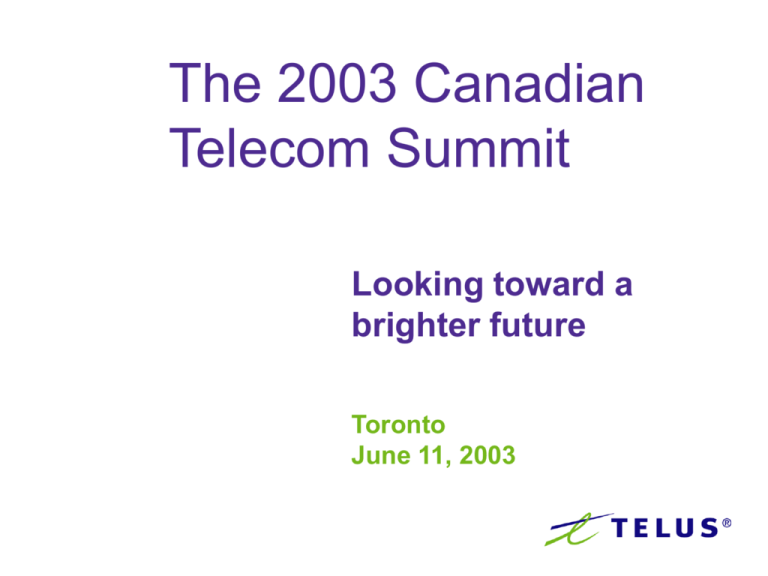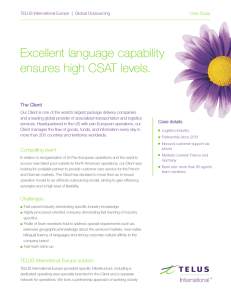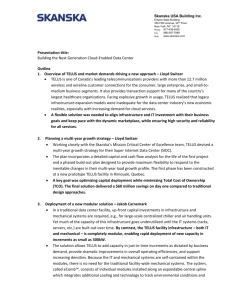cts20030611-RobertMcFarlane
advertisement

The 2003 Canadian Telecom Summit Looking toward a brighter future Toronto June 11, 2003 Surviving the “perfect storm” to reach a brighter future Robert McFarlane EVP & Chief Financial Officer agenda 3 the warm breeze - late 1990s the global perfect storm Canada’s perfect storm the perfect storm strikes TELUS lessons learned for a brighter future the warm breeze - late 1990s the warm breeze - late 1990s Economic expansion strong GDP growth inflation contained low interest rates 5 the warm breeze - late 1990s Historical North American Key Interest Rate Levels (1980 through present) 25% US Fed Funds Rate Bank of Canada Overnight Rate 20% 15% 10% 5% 6 Source: BMO Nesbitt Burns Jan-03 Jan-02 Jan-01 Jan-00 Jan-99 Jan-98 Jan-97 Jan-96 Jan-95 Jan-94 Jan-93 Jan-92 Jan-91 Jan-90 Jan-89 Jan-88 Jan-87 Jan-86 Jan-85 Jan-84 Jan-83 Jan-82 Jan-81 Jan-80 0% the warm breeze - late 1990s Economic expansion 7 strong GDP growth inflation contained low interest rates Emergence of e-enabled individual investor/trader the warm breeze - late 1990s emergence of e-trading TD Waterhouse 133% CAGR 40% CAGR 1994 2000 Active accounts 8 Source: TD Waterhouse 2000 Annual Report 1994 2000 Avg. e-trades per day the warm breeze - late 1990s Economic expansion strong GDP growth inflation contained low interest rates Emergence of e-enabled individual investor/trader Government surpluses reduced government debt issuance traditional fixed income investment into government bonds shifts to corporates Fixed income mandates shift to seeking more yield 9 emergence of liquid corporate high yield market the warm breeze - late 1990s 10 Capital markets supported aggressive growth revenue growth key attribute historical revenue growth trend nice but not necessary potential revenue growth would suffice over $925 billion of equity & debt issuance by telcos from 1995 to 2000 the warm breeze – late 1990s North American IPOs 714 U.S. Canada 589 475 443 505 480 263 64 246 175 63 348 327 294 321 150 479 155 185 107 51 1990 1991 1992 1993 1994 1995 1996 1997 1998 1999 Source: J.P. Morgan Securities 11 155 2000 the warm breeze - late 1990s 12 Capital markets supported aggressive growth revenue growth key attribute historical revenue growth trend nice but not necessary potential revenue growth would suffice over $925 billion of equity & debt issuance in 1995 to 2000 Capital market transitioned from “efficient” to “excessive” the warm breeze - late 1990s Relative Price Performance NASDAQ Composite Index v. NYSE Composite Index (January 1, 1998 - March 10, 2000) 350 NASDAQ 300 250 200 150 100 NYSE 13 Source: Bloomberg Dec-99 Dec-98 Dec-97 50 the warm breeze - late 1990s Say’s Law and Moore’s Law became accepted dogma in telecom Moore’s Law: data network traffic doubles every 2 years Future value creation apparently a function of building capacity: 14 Say’s Law: supply creates its own demand since market began valuing firms on asset multiples as proxy for future revenue growth the warm breeze - late 1990s Resulting valuation metrics: Wireless (POPs licensed, subscribers) CLECs (PP&E, bldgs. connected) IXCs (fibre miles built) 15 wireless penetration outlook Canadian wireless penetration: Prior expectation Revised - Sept ‘991 1 16 September 1999 Clearnet Investor Forum 2006E 40% 50-70% CLECs valued at multiples of PP&E 17 the warm breeze - late 1990s Worldcom success fuels copycats: high levels of capital investment high margins high growth high share price fuels growth by acquisition set new benchmarks for strategies of competitors 18 Worldcom vs. AT&T – capex intensity1 41% Worldcom AT&T 29% 29% 24% 23% 9.7% 9.5% 1995 1 19 15% 14% 1996 15% 1997 Ratio of capital expenditures to revenue Source: Company reports, Merrill Lynch 24% 15% 1998 1999 2000 Worldcom vs. AT&T – EBITDA margin 34% 33% 32% 32% 27% 27% 24% 29% 26% 25% 22% 18% 1995 1 20 1996 1997 Ratio of capital expenditures to revenue Source: Company reports, Merrill Lynch 1998 1999 2000 Worldcom AT&T Worldcom – enterprise value Worldcom Total Enterprise Value Analysis (December 31, 1990 - December 31, 2001) (US$M) $120,000 $100,000 $80,000 $60,000 $40,000 $20,000 Dec-01 Dec-00 Dec-99 Dec-98 Dec-97 Dec-96 Dec-95 Dec-94 Dec-93 Dec-92 Dec-91 21 Dec-90 $0 the warm breeze - late 1990’s Result: phenomenal capital investment in telecom 22 “build it and they shall come” ideology became standard basis for telecom business plans global telecom capital expenditures (US$B) $217 $221 $175 $154 1999 23 Source: Merrill Lynch 2000 2001 2002 $145 2003E the warm breeze – late 1990s global telecom services - capital raised $350 $300 47% CAGR (%) 47% CAGR (US$ Billions) $250 $200 $150 $100 $50 $0 1995 1996 1997 Equity 24 1998 Debt Source: Securities Data Corporation, RBC Capital Markets 1999 2000 the global perfect storm the global perfect storm North American technology meltdown Relative Price Performance NASDAQ Composite Index v. NYSE Composite Index (December 31, 1997 - June 6, 2003) 350 NASDAQ NASDAQ S&P/TSX 300 250 200 150 100 NYSE 26 Mar-03 Dec-02 Sep-02 Jun-02 Mar-02 Dec-01 Sep-01 Jun-01 Mar-01 Dec-00 Sep-00 Jun-00 Mar-00 Dec-99 Sep-99 Jun-99 Mar-99 Dec-98 Sep-98 Jun-98 Mar-98 Dec-97 50 the global perfect storm North American equity issuance – total (US$B) $185 $119 $94 2000 2001 Source: J.P. Morgan Securities 27 access to capital markets dries up 2002 the global perfect storm North American equity issuance - telecom 49 (US$B) 38 18 16 14 10 1995 10 8 1996 1997 1998 1999 2000 2001 2002 Source: J.P. Morgan Securities 28 telecom issuance peaks in 2000 then in free-fall the global perfect storm global issuer public debt default analysis 186 141 120 100 60 1998 1999 2000 Source: Moody’s Investors Services 29 number of defaults skyrocket 2001 2002 the global perfect storm global issuer public debt default analysis 1998 1999 2000 $30B $30B 2001 2002 $20B $107B Source: Moody’s Investors Services US$270B of public debt defaults in 2001/02 30 $163B the global perfect storm US CLEC1 value destruction Total Enterprise Value, Mar-00 Total Enterprise Value, post-restructuring $103B US$98B destroyed $4.5B 1 Composite comprised of, Teligent, Winstar, PSInet, McLeod and Global Crossing. Global Crossing enterprise value is as of May-99 31 Source: J.P. Morgan Securities Inc. the global perfect storm corporate malfeasance Accounting irregularities surface Investor confidence shaken generally & Worldcom/ Qwest/Adelphia placed focus on telecom sector 32 US political reaction: passed Sarbanes-Oxley Act in 45 days Investor flight to safety, any telecom not considered safe the global perfect storm cash becomes King again Credit agencies didn’t see it coming investor backlash 33 reacted by raising the bar becoming significantly more conservative Equity and debt market raised the bar: cash is King! Capital markets closed to negative cash flow stories the global perfect storm global credit rating activity - telecom 783 Upgrades Downgrades 611 34 12 13 49 31 30 56 1995 1996 1997 Source: Moody’s Investors Services 173 123 121 97 129 45 1998 1999 2000 58 2001 35 2002 the global perfect storm capital spending ambitions scaled back Capex Intensity Trend Analysis 2 US RBOCs US Wireless Sprint FON AT&T 2001 2002 Q1-03 25% 34% 31% 13% 18% 26% 14% 10% 11% 14% 10% 7% Sources: Company reports, Merrill Lynch 1 35 Ratio of capital expenditures to revenue comprised of SBC Communications, Verizon, and BellSouth 2 Composite the global perfect storm telecom meltdown “. . . 24 of the nation's 29 top telecommunications companies that have not yet filed for bankruptcy are at risk of doing so in coming months. Only a few companies - among them Verizon, Cisco Systems, SBC and BellSouth - are relatively free from the risk of toppling into insolvency . . .” - June 18, 2002 36 Canada’s perfect storm Canada’s perfect storm telecom underperforms TSX Relative Performance S&P/TSX Composite & Telecom Services Sub-Index1 (December 31, 1997 - Present) 180 TSX 160 140 120 100 80 60 Telecom 40 20 S&P/TSX Telcom Services Sub-Index (Adj.) 38 1 Dec-02 Dec-01 Dec-00 Dec-99 Dec-98 Dec-97 0 Adjusted to include companies previously removed: Call-Net, Microcell, 360networks, GT Group Telecom, Microcell, and AT&T Canada Cdn alternate carrier revenue growth stagnates ($M) 1,545 1,505 1,489 AT&T Canada Call-Net GT Group 1,250 929 801 209 1191 73 39 2000 1Includes 2001 only Q1 and Q2 before GT’s CCRA filing 2002 Canadian alternate carrier debt value destruction balance sheet debt before restructuring balance sheet debt after restructuring Call-Net $500M Call-Net AT&T Canada $2.6B AT&T Canada $0B GT $4.7B $1.6B Microcell Microcell 360 networks $2.7B $13.6B 40 $2.0B $350M 360networks $215M $1B Canada’s perfect storm value destruction emulates US experience Capital no longer available for telcos with no prospect of cash flow Liquidity crisis emerges in 2002 Similar outcome as per US: 41 restructurings destruction of value Outcome was not regulatory induced but rather inevitable consequence of global perfect storm TELUS/Bell West non-ILECs source of intense competition $527M $368M $335M $182M $84M 2000 42 $58M 2001 2002 TELUS East (Non-ILEC) 2000 2001 Bell West 2002 Regulatory impacts 43 Contribution & rebanding decisions significantly reduce subsidies to ILECs for below-cost rural service Announced in 2001, effective January 2002 Decisions significantly benefit non-incumbent long distance carriers 2002 price cap decision on local rates further hurt ILECs – also hurt CLECs the perfect storm strikes TELUS strategic imperatives 2000-2003 45 Provide integrated solutions Build national capabilities Partner, acquire & divest as necessary Focus relentlessly on growth markets Go to market as one team Invest in internal capabilities build national capabilities TELUS national infrastructure – 2000 Add ML map - network before expansion 46 build national capabilities TELUS’ national infrastructure - 2003 Add ML map - network after expansion 47 regulatory tornado hits TELUS with little warning TELUS’ Assessment ($268M) 2002 2003 ($211M) ($211M) ($57M) ($75M) ($75M) Contribution & Rebanding Price Cap 48 ($343M) TELUS’ perfect storm arrives TELUS Common Equity (February 1, 2001 - July 26, 2002) $45 ~April 2001 CRTC Contribution & Rebanding decision $40 $35 Oct 25 Dividend reduced to $0.15 from $0.35 $30 Mar 21 BCE earnings warning $25 Jun 25 WorldCom fraud $20 ~Aug-Nov 2001 Enron collapse $15 May 5 Annual General Meeting & Q1 results $10 May 31 Initial reaction to CRTC price cap decision Jul 25 Moody's downgrade 49 Jul-02 Jun-02 May-02 Apr-02 Mar-02 Feb-02 Jan-02 Dec-01 Nov-01 Oct-01 Sep-01 Aug-01 Jul-01 Jul-01 Jun-01 May-01 Apr-01 Mar-01 Feb-01 $5 TELUS recovery plan Increased focus on cash flow generation reduced dividend by 57% offsetting cash impact of contribution decision – Fall 2001 Operational Efficiency Plan commenced focus on improved capital efficiency continued successful execution by Mobility 50 operational efficiency program (OEP) Staff Reductions (net) 7,300 Annual Cost Savings $550M 6,600 $245M March 2003 Actual 2003E 2004E OEP leads to ~29% reduction of wireline employee base 51 invest where there is industry growth 8.5% 6.9% Local LD Data Wireless (1.0)% (3.8)% Estimated 3-year industry revenue growth (CAGR% 2003-2006) 52 Source: TELUS estimates for Canadian industry revenue growth TELUS capex & capex intensity1 37% $3.0 $2.5 28% 29% $2.6 30% 24% $2.0 $1.5 40% Capex in billions 35% 20% $1.8 $1.7 $1.6 $1.5 25% 20% 15% $1.0 10% $0.5 5% $0.0 0% 1999 1 53 2 2000 20012 Ratio of capital expenditures to revenue Includes $356 million for wireless spectrum 2002 2003E how does TELUS Mobility measure up? TM 2003 guidance Cdn Avg 2003 US Avg 2003 EBITDA / network rev. 34% 26% 32% Annual EBITDA growth rate 29% 16% 15% Capex intensity1 20% 18% 21% (EBITDA – Capex) / tot. rev2 11% 5.3% 9.2% Mkt penetration/cov. POPs 12% 41% 53% No. of carriers in market 3 to 4 3 to 4 6 to 8 Penetration gain/carrier3 1.2% 0.9% 0.5% Sources: TELUS estimates. Cdn. Statistics - Company Reports; US Statistics - Company Reports and Morgan Stanley 1 Projected capex as a % of forecast total revenue. 2 Projected EBITDA less projected Capex divided by projected total revenues 3 Projected wireless penetration gain divided by # of carriers in market. For TELUS, projected net adds divided by projected covered POPs 54 TELUS Mobility is a premium wireless provider operating in rational Cdn wireless industry wireless penetration outlook Canadian wireless penetration: Prior expectation 55 2006E 40% Revised - Sept ‘99 50-70% Current expectation approx. 50% brightest future ever for Cdn. wireless industry 56 Rational industry structure supports competition Financial prospects very bright for those with good strategies, well-executed Stable revenue per subscriber Among lowest churn rates in the world Producing positive free cash flow for the first time since inception in 1985 TELUS free cash flow1 $500 to 600M 2001 2002 $(26)M 2003E $(1.35)B 1 57 EBITDA less capex, cash interest, cash taxes, cash dividends; excludes restructuring & workforce reduction costs TELUS recovery plan Increased focus on cash flow generation reduced dividend by 57% offsetting cash impact of contribution decision – Fall 2001 Operational Efficiency Program commenced focus on improved capital efficiency continued successful execution by Mobility Enhanced public disclosure – Summer 2002 58 bank covenants disclosed increased Investor Relations communication issued 2004 cash flow guidance early TELUS corporate governance 59 Took comprehensive action in 2002 Supports direction in US of Sarbanes-Oxley/SEC Supports Canada’s proposed National Policy on disclosure & Ontario’s Bill 198 TELUS corporate governance response to concerns Enhancements include: 60 Not Required required CEO & CFO certification of Financial Statements & MD&A Disclosure controls & procedures Enhance MD&A Ethics policy update & disclose Whistle blower hotline Improve risk management process External auditor independence TELUS recovery plan Increased focus on cash flow generation reduced dividend by 57% – Fall 2001 - offsetting cash impact of contribution & rebanding decision Operational Efficiency Plan commenced focus on improved capital efficiency continued successful execution by Mobility Enhanced public disclosure – Summer 2002 61 bank covenants disclosed increased Investor Relations communication issued 2004 cash flow guidance early Debt buyback / equity issue – Aug/Sept 2002 Reduce leverage strategy & execution paying off TELUS Bond Performance $120 Apr 30 Annual General Meeting & Q1 Results Feb 14 Q4 results Sep 12 Equity offering & debt buyback $100 Apr 16 Moody's outlook upgrade to stable May 29 Fitch outlook upgrade to stable $80 Dec 16 2003 targets release Nov 4 Q3 results $60 C$ 7.5% 2006 US$ 7.5% 2007 Jul 29 Q2 results & increased disclosure US$ 8.0% 2011 62 May-03 Apr-03 Mar-03 Feb-03 Jan-03 Dec-02 Nov-02 Oct-02 Sep-02 Aug-02 Jul-02 $40 2003 outlook leading North American telecom performance Projected EBITDA Growth Rates – 2003E 9.2% 5.3% 5.0% Aliant Verizon Sprint TELUS BCE MTS (0.6%) Bell South AT&T SBC (2.0%) (4.5%) (6.3%) (13.0%) (21.2%) Note: TELUS data based on 2002 actual results & average of 2003 targets Other 2003 estimates provided by TD Securities, based on analysts estimates 63 2003 outlook leading North American telecom performance Projected EBITDA-Capex Growth Rates – 2003E 52.3% 18.4% 11.5% 8.5% 7.0% 1.5% TELUS BCE MTS Aliant Sprint Bell South SBC Verizon AT&T (0.6%) (4.6%) Note: TELUS data based on 2002 actual results & average of 2003 targets Other 2003 estimates provided by TD Securities, based on analysts estimates 64 (19.9%) strategy & execution paying off - equity TELUS Equity Performance $25 Nov 4 Q3 results $20 Sep 12 Equity offering & debt buyback $15 Dec 16 2003 targets release Feb 14 Q4 release Apr 30 Annual General Meeting & Q1 results $10 Jul 29 Q2 results & increased disclosure 65 May-03 Apr-03 Mar-03 Feb-03 Jan-03 Dec-02 Nov-02 Oct-02 Sep-02 Aug-02 Jul-02 $5 Lessons learned for a brighter future lessons learned 67 Customers & investors should determine telecom winners and losers, not regulator Do not ask regulators to subsidize poor strategies, poorly executed CLEC/alternate carrier failures in Canada consistent with US experience, not due to CRTC Debt-free ‘fallen angels’ source of rejuvenated competition Bell & TELUS geographic expansions are source of increasingly intense competitive rivalry lessons learned 68 TELUS has incurred ~$350M of reduced operating profit due to price cap and contribution/rebanding regulatory decisions Regulatory decisions should ideally be consistent, transparent and sensitive to capital market considerations Unlike US, Canada has evolved to correct wireless industry structure TELUS Mobility is producing best-in-class results and we are now experiencing the brightest future ever for Cdn. wireless industry despite moderating growth TELUS experience in past year shows that good telecom strategy consistently well-executed will be rewarded despite regulatory and other external adversity questions?








